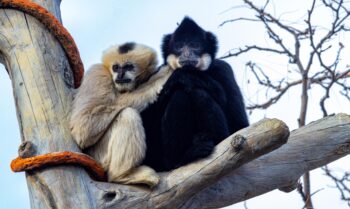July 25, 2019
Leaving the Nest
Understanding Species Survival Plans and Denver Zoo’s Role in Helping Species Thrive
By Jessica Meehan
In May, animal care staff at the Denver Zoo bid farewell to our mischievous kea Milford when he left for his new home at the Tracy Aviary in Salt Lake City. Sending birds to other institutions isn’t new, but with every goodbye, I’m reminded of how much our guests and animal care staff miss these animals as they move on. And with each move, we often get the same question: why do these animals leave in the first place?
When an animal—whether it’s a kea or an Amur tiger—arrives to or departs from Denver Zoo, it comes at the recommendation of the Association of Zoos and Aquariums (AZA) Species Survival Plan (SSP). The SSPs ensure that there are thriving, genetically diverse populations of each species across all AZA-accredited facilities. SSPs have been compared to a dating service for our animals, matching animals that would be a genetically and behaviorally compatible to meet the population needs for their species. With so many animals under our care, there would be no way for each individual zoo to manage these populations scientifically, so we work together by assigning a population manager to each SSP.
Denver Zoo is home to almost 20 SSP Coordinators, animal care team members who are given time and financial support to oversee the entire population of that species. It’s no easy task, and I speak from experience. As SSP Coordinator for kea for more than 10 years, I made the difficult, yet necessary decision to send Milford to Tracy Aviary, where a year earlier, we sent his older sister Scarlet. Knowing what the kea population needs, I feel like these goodbyes are a cause for celebration!
The kea population in North America is very small, with only around 35 birds living at 12 AZA-accredited zoos. While kea are a long-lived species, it’s critical for a certain number of chicks to hatch each year to sustain a healthy population. There are only two zoos in North America successfully breeding kea in recent years (with some others showing nesting and egg-laying) – Cincinnati Zoo and Denver Zoo. In 2018, Milford was the only kea to hatch the entire year, so you can see how vital the work we’re doing is to the overall population.
Because each species is unique, each SSP coordinator deals with different challenges in creating a sustainable population. The biggest challenge for the kea population is figuring out why our breeding success is so low. The population has up to eight breeding pairs at institutions across the country, yet only one or two pairs produce chicks each year. While there are many factors that could be involved, one possibility we are exploring is pair compatibility. Just because a pair of birds are an ideal genetic match doesn’t mean that the birds will get along once they are together. A possible solution we're exploring is to provide mate choice opportunities for kea so they can have the best chance of success! This idea mimics wild kea behavior, in which juvenile kea leave their home territory and roam together in flocks for several years before settling down with a mate.
Enter Tracy Aviary, where they invested in a new flagship kea habitat to provide young kea the chance to mingle with other kea and choose their own mate. Denver Zoo and Cincinnati Zoo have sent our genetically compatible young kea to Tracy Aviary to live as a group, just as they would in the wild. As the years pass and pairs form, they will move to other zoos to settle in a new home territory. We’re hoping this investment pays off and we see higher success for kea breeding in the near future! And Milford has an even more special role since the only female at Tracy Aviary right now is his sister. He has been chosen to be trained as an ambassador kea during his juvenile years until unrelated females become available. He’ll be showing off his remarkable intelligence and curiosity during training sessions in the free flight Outdoor Bird Show at Tracy Aviary!
Multiply this little story by more than 450 SSPs managed by AZA zoos and aquariums and you begin to get an idea of how big this picture can get! While saying goodbye to some of our animals is tough, it’s always an adventure when we welcome new animals to Denver Zoo. African lion Tobias and Amur tiger Yuri, recent arrivals to the Zoo, both came to us at the recommendation of their respective SSPs. Knowing that our populations are managed this way, for the best interest of the individual animals and their role for their species, makes the bitter a little sweeter when we send our little ones out into the world.
Subscribe
Be among the first to hear the latest animal updates, important stories and details about all the fun happening around Denver Zoo.
Tags
-
 April 15, 2024
April 15, 2024Good Luck, Chuck!
Good Luck, Chuck! Beloved Bachelor Relocating as Part of Asian Elephant Species Survival Plan In a heartfelt and collaborative…
-
 April 15, 2024
April 15, 2024African Impact
African Impact Two New African Field Conservation ProgramsAim to Protect Gorillas + Grey Crowned Cranes We're honored to provide…
-
 March 1, 2024
March 1, 2024Last Place(s) on Earth
Last Place(s) on Earth New Asian Field Conservation Programs Protect Asian Elephants, Sumatran Orangutans + more Indonesia's Leuser Ecosystem…

